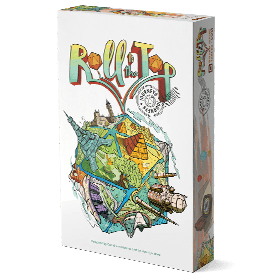Roll to the Top: Journeys
 Giza Piramidi'nden Matterhorn'a kadar dünyanın her yerindeki inanılmaz simge yapılara seyahat edin. Genç sanatçının yolculuğunu, seyahatinin ayrıntılarını anlatmak üzere evine ailesine gönderdiği kartpostallar aracılığıyla takip edin.
Giza Piramidi'nden Matterhorn'a kadar dünyanın her yerindeki inanılmaz simge yapılara seyahat edin. Genç sanatçının yolculuğunu, seyahatinin ayrıntılarını anlatmak üzere evine ailesine gönderdiği kartpostallar aracılığıyla takip edin.
Roll to the Top'da tüm oyuncular seyahat tahtalarını doldurmak için aynı zar havuzunu kullanır. Kutuları doldururken yerleştireceğiniz sayılar altlarındaki sayılardan büyük veya onlara eşit olmalıdır, bu yüzden dikkatli plan yapın!
Tahtasını tamamen dolduran ilk oyuncu kazanır.
Oyuncu sayisi: 1 - 6
Oyun süresi: 8 mn
karmaşıklık: 0 / 5
Roll to the Top: Journeys ve 1194 başka oyun online oyna.
İndirmeye gerek yok, direkt web tarayıcın üzerinden oynanabilir.
Arkadaşların ve dünyadaki binlerce oyuncuyla.
Ücretsiz.

Roll to the Top: Journeys ve 1194 başka oyun online oyna.
İndirmeye gerek yok, direkt web tarayıcın üzerinden oynanabilir.
Arkadaşların ve dünyadaki binlerce oyuncuyla.
Ücretsiz.

Kisa kural
OVERVIEW
Roll to the Top: Journeys is a roll and write game. Dice rolls determine the numbers available to play with and you decide which ones to place on your board and where to place them. The goal is to be the first to fill all the spaces on your board.
THE DICE
There are 5 number dice and one action die. Each turn, the Action Die and anywhere from one (1) to five (5) number dice are rolled. Players take turns deciding which die to add or remove for the following turn’s roll, based on the results of the Action Die.
Action Die
The Action Die is rolled along with the number die or dice and results in the active player taking one of three possible actions: add a die to the active pool, remove a die from the active pool, or swap an inactive die with an active one.
It is a six-sided die with 2 opportunities to roll the + (add), 2 opportunities to roll the – (remove), one opportunity to swap (indicated by the blue arrows pointing in opposite directions), and one opportunity for +/- which allows the active player to choose whether to add or remove a die.
There are three scenarios where the action is already determined, regardless of the action die. These are:
- If all 5 dice are already in the active pool, the active player must remove a die.
- If only one die is in play, the active player must add one.
- If no player writes a number on their board, the active player must add a die.
- If none of these three scenarios apply, the active player will take the direction indicated by the result of the rolled action die.
Number Dice
There are 5 dice, each with different number values, as follows:
- d4 (4-sided die) with the numbers 1, 2, 3, and 4
- d6 (6-sided die) with the numbers 1,2,3,4,5, and 6
- d8 (8-sided die) with numbers 1 through 8
- d12 (12-sided die) with numbers 1 through 12
- d20 (20-sided die) with numbers 1 through 20
GAME PLAY
Each turn, the active dice are rolled and all players, simultaneously, use the numbers to fill spaces on their board.
Players can use some, all, or none of the numbers rolled each turned. Numbers can be added to create larger numbers, but no number can be used more than once.
Example: The dice roll results in a 2, 5, and 5. Players can place each separately on their board, or they can place 2 and 10 or 5 and 7. They would not be able to place a 2, 5, and 7.
Once all players have chosen and placed their numbers, the active player (the one who hold the action die) makes their choice to add, remove, or swap dice based on the instructions of the action die and the rules above. Then the dice are rolled and a new turn starts.
Filling Spaces with Numbers
When placing numbers on the board, players must follow these rules:
- Each box can contain a single number
- Dice results can be used on their own or added together to make greater numbers
- Each dice can only be used once, regardless of if it’s used on its own or combined with others
- You don't have to use all of the numbers if you don't want to, and can even choose not to play any of the rolled numbers
Placement Restrictions
Boxes with dots in their lower right corner can contain any number. All other boxes have the following restrictions:
- You can only fill a space when the box(es) supporting it below have a number in them.
- Players can only place numbers which are greater than or equal to the number(s) below it.
- Spaces that don’t sit on any other space, are considered hanging spaces. Hanging can contain any number, similar to the starting spaces with dots. The difference is that since spaces don’t sit on others, they can’t be filled until an adjacent space to its right or left is filled.
GAME END
The games ends when one or more players fill every space on their board. The winner is determined when the turn is over, so if more than one player fills their board in the same turn the result is a tie.

